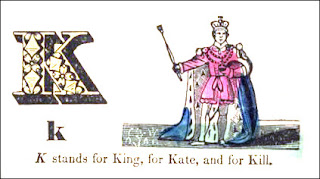Do you know your A B C's? Each Letter Character Has a History and a Reason For Its Present Form? Have you Ever Questioned Origin and Significance of the Alphabet?
 |
| "Illuminate Your Initial" art lesson at Thrifty Scissors. |
We derived twenty-three of our letters from the Romans. They had taken probably eighteen of these from the Greeks about the fourth century B. C. and afterwards borrowed elsewhere or invented seven more. Instead of giving them names as the Greeks did, they simply called them by the sounds for which they stood: A (ah), B (bay). They introduced the curve wherever possible, whereas the early Greek letters were all angular- what an interesting analogy is evident in the architecture of those
two peoples, the temple pediment and angularity of the Greeks as contrasted with the dome and arch of the Romans.
The Greeks, in their contact with those great traders and "Yankees of ancient time," the Phoenicians, saw the value of their alphabetic writing and inaugurated its use about the time of the first Olympiad, 776 B. C. Three or four centuries before they gave it to the Romans the ancient Greeks found use for fifteen of the Phoenician letters and then conceived enough to round out an alphabet of twenty-four characters.The changes that took place in the shape of their letters can be attributed to their sense of order; the letters are balanced better and the parts better related.
 |
| Latin Uncial and Minuscule. |
THE Greeks were interested in the sound value only, not in the picture value of the symbol, and, therefore, they probably did not notice that A, for instance, had ever been a picture of the head of an ox and that it was now drawn upside down; and that the Phoenician name "Alpeh" meant ox and that they mispronounced the sound in calling it "Alpha." The Romans borrowed from the Greeks and the Greeks had borrowed from the Phoenicians, but where did the Phoenicians obtain their letters? Did they invent them? To what extent were these letters influenced by earlier systems of writings as those employed by the Cretan, Assyrian and Egyptian civilizations? These are questions that probably will never be answered satisfactorily. Many arguments and theories are advanced. We can, however, trace back with certainty a number of our letters to the Phoenician alphabet of 1000 B. C. Beyond this all is, at present, a matter of conjecture.
The Phoenician alphabet consisted of twenty-two pictures of familiar objects. These pictures were rudely and simply made, for writers and readers soon recognized the fundamental characteristics and all unnecessary details were eliminated. The great advance that can be credited to them is that they realized that a small number of sound-expressing characters, if well selected, are sufficient to express any word. Other races at this period had phonetic systems but they consisted of numerous symbols and cumbersome appendages of non-alphabetic characters- "eye pictures" side by side with "ear pictures." No doubt earlier Phoenician writing passed through the stages of development traceable in so many countries:
- The pictures or characters suggesting the thing or incident (picture writing).
- The pictures or characters symbolizing the thing or idea (ideographic or symbolic writing).
- The pictures or characters representing the sound of the thing or idea (phonograms).
- The sign suggesting the various sounds of the language (alphabetic system).
To free this last stage from the others was the great Phoenician contribution.
- Search all of the alphabet coloring pages at one time
- Search My English Alphabet Letter Coloring Pages by Letter Only: Aa Bb Cc Dd Ee Ff Gg Hh Ii Jj Kk Ll Mm Nn Oo Pp Qq Rr Ss Tt Uu Vv Ww Xx Yy and Zz
- Search for Coloring Pages About Primary, Secondary and Additional Color Word Identification
- Colorful Animal Alphabet Flash Cards
- Color the Children's Horn Books - early illustrations of horn books
 |
| A simple ABC activity that I made for my preschool students several years ago. Follow the link to download the palm leaves and read instructions. |
Looking For Number Coloring Too?













